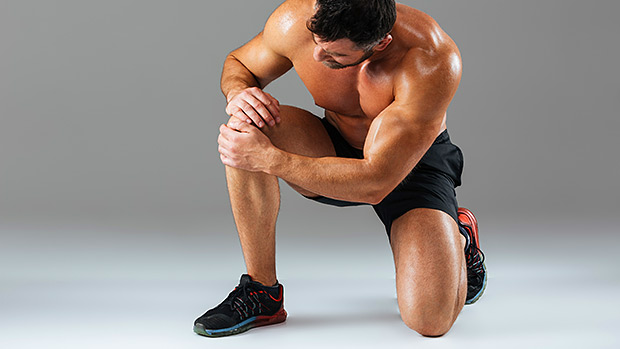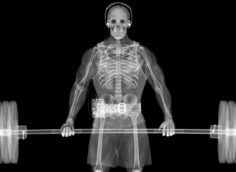Why do squats cause knee pain? Often it's a lack of mobility. To do a pain-free, good looking squat, you need to have mobile ankles and hips. If you never do anything to address your crappy mobility, you may end up with a squat that looks like this:
Yeah, don't do that. You can see where I could easily develop knee problems from this squat. I'm doing a poor job of pushing my hips back, plus my heels are lifting, placing a lot of sheer stress across the knee.
If your squat looks even remotely like this, it's time to address your lower-body mobility so that you don't run into problems down the road. Here are three things you should do before your next squat day to get yourself in better alignment.
1. Banded Ankle Mobilization
If you have immobile ankles, you won't be able to keep your heels planted on the ground when squatting. Having your knees travel over your toes is only acceptable if you can maintain three points of contact with your foot. These three points consist of your heel, big toe (base of your first metatarsal), and pinky toe (base of your fifth metatarsal).
If you're unable to keep your weight evenly distributed over these three points, you'll inevitably have knee problems.
Banded ankle mobilizations work by pulling the bones of the ankle back into better alignment. This will allow for better dorsiflexion of the ankle and will allow your shin to stay perpendicular to the ground when squatting.

For this drill to work, place the band across your talus bone on your ankle instead of higher up on the shin. You can also use your palms to press down on your knee.
2. Banded Hip Mobilization
When squatting, the hips need to sit back when you initiate the movement. If your hips are immobile, one of two things will happen:
- You'll be pushed forward and your knees will be responsible for taking all the pressure.
- You'll force your hips back, but since you have no hip disassociation, your lower back will be essentially "glued" to your hips and you'll be forced into flexion. That could mean lower back problems in the future.
Banded hip mobilizations work by pulling your femur into better alignment in the acetabulum of your hip. They allow the joint capsule in your hip to "open up" which will help you to get better hip disassociation. This means you'll be able to move your hips through their intended motion without needing to compensate with your lower back.
This drill can also be very useful for individuals who suffer from hip impingement.
3. Spanish Squat
If you currently have patellar tendon issues, this can be a great way to both reduce your pain and fire up your quads before you squat.
This exercise works by pulling your tibia forward which will help reduce compression on your knee. It also allows you to practice sitting your hips back without worrying about your knees traveling forward.
Try holding the squat position for about 5 seconds before returning to a standing position. As you return to the standing position, drive your knees back against the band. This acts as a terminal knee extension or "TKE" exercise and will strengthen your quads.





